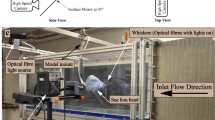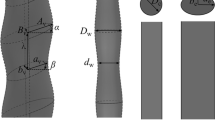Abstract
Certain species of seals are able to faithfully detect minute disturbances in ambient water solely using their whiskers, which is attributed to the whiskers’ undulating three-dimensional (3D) morphology. While previous studies have examined effects of key morphology parameters on the wake using scaled-up whisker models, it is unclear how the wake behaves when induced by a real undulating seal whisker. Real seal whiskers usually have a diameter of about one millimeter and present variation in size and bending curvature along the length, which are not being considered in designing scaled-up whisker-like models. In addition, how the whisker orientation affects the induced wake and vortex shedding needs to be clarified. This work examines the wake flow characteristics generated by a real elephant seal whisker (of undulating morphology) and a California sea lion whisker (of smooth morphology) in laboratory water channels at Reynolds numbers of 110 and 390, using snapshot particle image velocimetry (PIV) and time-resolved PIV methods. Results indicate that the reversed flow region is remarkably reduced and turbulence intensities are greatly suppressed behind the undulating whisker compared to that of the smooth whisker, when the major axis of the whisker cross-section is parallel with the incoming flow (i.e., the angle of attack or AOA is 0\(^{\circ }\)). While the vortex shedding frequency is reduced for both the undulating and smooth whiskers, the power spectral density is substantially increased at an \(\mathrm{AOA} = 90^{\circ }\) in comparison to \(\mathrm{AOA} = 0^{\circ }\). Regardless of the AOA, the power spectral density is approximately 40% lower in the wake of the undulating whisker than that of the smooth whisker, indicating the favorable hydrodynamic feature of the undulating whisker. The extraordinary hydrodynamic traits of undulating seal whiskers is promising for renovating aero-propulsion flow components and designing high-sensitivity underwater flow sensors.
Graphical abstract














Similar content being viewed by others
References
Adrian RJ, Westerweel J (2011) Particle image velocimetry. Cambridge University, New York
Beem H (2015) Passive wake detection using seal whisker-inspired sensing. PhD Dissertation, Joint Program in Oceanography and Applied Ocean Sciences and Engineering, MIT and WHOI, Cambridege
Beem H, Triantafyllou M (2015) Wake-induced slaloming response explains exquisite sensitivity of seal whisker-like sensor. J Fluid Mech 783:306–322
Boeuf B, Naito Y, Asaga T, Crocker D, Costa D (1992) Swim speed in a female northern elephant seal–metabolic and foraging implications. Can J Zool 70:786–795
Dehnhardt G, Kaminski A (1995) Sensitivity of the mystacial vibrissae of the harbour seals (Phoca vitulina) for size differences of actively touched objects. J Exp Biol 198(11):2317–2323
Fish F, Howle L, Murray M (2008) Hydrodynamic flow control in marine mammals. Integr Comp Biol 48(6):788–800. https://doi.org/10.1093/icb/icn029
Ginter C, DeWitt T, Fish F, Marshall C (2012) Fused traditional and geometric morphometerics demonstrate pinniped Whisker diversity. PLoS One 7(4):e34481
Ginter C, Fish F, Marshall C (2010) Morphological analysis of the bumpy profile of phocid vibrissae. Mar Mammal Sci 26:733–743
Hanke W, Witte M, Miersch LI, Grede M, Oeffner J, Michael M, Hanke F, Leader A, Denhardt G (2010) Harbor seal vibrissae morphology suppresses vortex-induced vibrations. J Exp Biol 213:2665–2672
Hans H, Miao J, Triantafyllou M (2014) Mechanical characteristics of harbor seal ( Phoca vitulina) vibrissae under different circumstances and their implications on its sensing methodology. Bioinspiration Biomim 9:036013
Hans H, Miao J, Triantafyllou M, Weymouth G (2013) Whisker-like geometries and their force reduction properties, OCEANS MTS/IEEE Conference
James H, Dykes RW (1978) Some experiments on navigation in the harbour seal, Phoca vitulina. Anim Migr Navig Homing 7:395–404
Keane RD, Adrian RJ (1993) Theory and simulation of particle image velocimetry. In: Proceedings Volume 2052, fifth international conference on laser anemometry: advances and applications. https://doi.org/10.1117/12.150541
Kim HJ, Yoon HS (2017) Effect of the orientation of the harbor seal vibrissa based biomimetic cylinder on hydrodynamic forces and vortex induced frequency. AIP Adv 7:105015
Lin YF, Bai HL, Mahbub Alam Md, Zhang WG, Lam K (2016) Effects of large spanwise wavelength on the wake of sinusoidal wavy cylinder. J Fluids Struct 61:392–409
Miersch L, Hanke W, Wieskotten S, Hanke FD, Oeffner J, Leder A, Brede M, Witte M, Dehnhardt G (2011) Flow sensing by pinniped whiskers. Philos Trans R Soc B Biol Sci 366(1581):30773084
Morrison HE, Brede M, Dehnhardt G, Leder A (2016) Simulating the flow and trail following capabilities of harbour seal vibrissae with the lattice Boltzmann method. J Comput Sci 17:394402
Murphy C (2013) Structure and function of pinniped vibrissae, PhD Dissertation, University of South Florida
Murphy C, Reichmuth C, Eberhardt WC, Calhoun BH, Mann DA (2017) Seal whiskers vibrate over broad frequencies during hydrodynamic tracking. Sci Rep 7:8350
New T, Shi S, Liu Y (2015) On the flow behaviour of confined finite-length wavycylinders. J Fluids Struct 54:281296
Raffel M, Willert C, Werely S, Kompenhans J (2007) Particle image velocimetry: a practical guide. Springer, Berlin
Raman SK, Prakash KA, Vengadesan S (2013) Effect of axis ratio on fluid flow around an elliptic cylinder: a numerical study. J Fluids Eng 135:111201
Renouf D, Gaborko L (1982) Speed Sensing in harbour seal. J Mar Biol Assoc UK 62(01):227–228
Rinehart A, Shyam V, Zhang W (2017) Characterization of seal whisker morphology: implications for whisker-inspired flow control applications. Bioinspir Biomim 12:066005
Shyam V, Ameri A, Pointsatte P, Thurman D, Wroblewski A, Synder C 2015) Application of pinniped vibrissae to aeropropulsion. In: Proceedings of ASME Turbo Expo
Tavoularis S (2005) Measurements in fluid mechanics. Cambridge University Press, Cambridge, p 48
Wang S, Liu Y (2016) Wake dynamics behind seal-vibrissa-shaped cylinder: a comparative study by time-resolved particle velocimetry measurements. Exp Fluids 57:32. https://doi.org/10.1007/s00348-016-2117-9
Wieneke B (2015) PIV uncertainty quantification from correlation statistics. Meas Sci Technol 26(7):110
Witte M, Hanke W, Wieskotten S, Miersch L, Brede M, Dehnhardt G, Leder A (2012) PIV measurements of the near-wake behind a sinusoidal cylinder. Nat Inspir Fluid Mech NNFM 119:271289
Zhang W, Daichin Lee SJ (2005) PIV measurements of the near-wake behind a sinusoidal cylinder. Exp Fluids 38:824–832
Acknowledgements
This research is supported by the Faculty Startup Funds from the Office of Research at the Cleveland State University. The Authors would like to acknowledge Mr. David Epperly for assistance in experimental setup and the Civil Engineering Department for the access to the water channel. The authors also thank the NSF East Asia and Pacific Summer Institute for U.S. Graduate Students Program (NSF EAPSI 1515471) for the great opportunity to conduct high-speed PIV experiments at the Biofluid and Biomimic Research Center (BBRC) of the Pohang University of Science and Technology, Republic of Korea.
Author information
Authors and Affiliations
Corresponding author
Rights and permissions
About this article
Cite this article
Bunjevac, J., Turk, J., Rinehart, A. et al. Wake induced by an undulating elephant seal whisker. J Vis 21, 597–612 (2018). https://doi.org/10.1007/s12650-018-0484-4
Received:
Revised:
Accepted:
Published:
Issue Date:
DOI: https://doi.org/10.1007/s12650-018-0484-4




